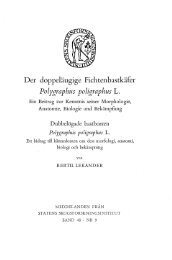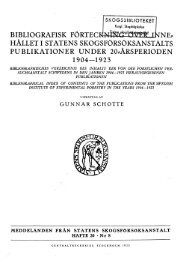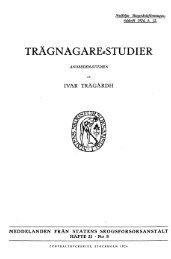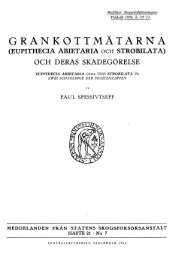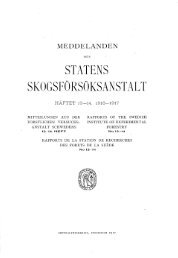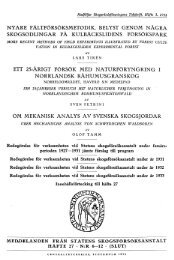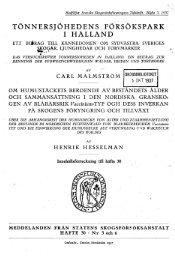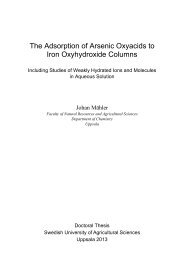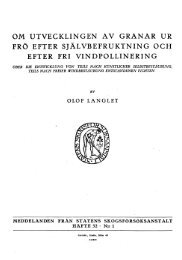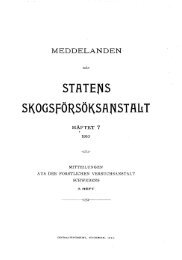Ekologi, skog och miljö - Epsilon Open Archive - Sveriges ...
Ekologi, skog och miljö - Epsilon Open Archive - Sveriges ...
Ekologi, skog och miljö - Epsilon Open Archive - Sveriges ...
Create successful ePaper yourself
Turn your PDF publications into a flip-book with our unique Google optimized e-Paper software.
ecosystem, which strongly influenced how ecologists viewed their science. Then,<br />
in the 1950’s, Eugene Odum guided ecology research into studies of ecosystems.<br />
One such study, Ecology of the Conifer Forest Landscape (Barr<strong>skog</strong>slandskapets<br />
ekologi) was carried out in Sweden in the 1970’s. It took a holistic view of<br />
energy, nutrient and water flows, as well as biomass production in a forest<br />
ecosystem. Landscape ecology, which came into focus during the beginning of<br />
the 21st century, has led to an expanded view on ecological relationships, based<br />
on a new understanding among ecologists that influences among various<br />
ecosystems exist even over large areas.<br />
The utilization of forests<br />
During the 18 th century, forest companies and industrial communities considered<br />
the forest as a natural resource just like they would a mine. The existing timber<br />
volume, especially of tall trees of large diameter, was the recognized asset. Farmers<br />
used the forest for extraction of wood for household purposes, wood for charcoal<br />
and timber, and did slash-and-burn clearing of forests to create pastures.<br />
This situation lasted until the mid 1800’s, when the rapid development of the<br />
sawmill industry started. Simultaneously, in a major land reform process<br />
(”avvittringen”), large forest areas were transferred to the farmers who were<br />
caught between the companies’ land and timber purchases. There was no room<br />
for active forest regeneration or other silvicultural measures.<br />
All forests in the country were exploited. In northern Sweden (Norrland) the<br />
exploitation went on into the 1940’s. As a consequence, the timber supply<br />
decreased there, whereas in other parts of the country a slight increase was<br />
observed during the first National Forest Inventory in the 1920’s. After the Second<br />
World War, the Government, the Parliament, and the forest industry all realized<br />
that the condition of the forests had to be improved, to avoid jeopardizing forest<br />
growth and future yields completely. Restoration of the forests was commonly<br />
discussed – a confession of earlier failures in forest management. The first active<br />
step initiated by the Government was the Forestry Act of 1948, and was the first<br />
complete forest legislation in Sweden. The essence of it still remains in force<br />
today.<br />
Along with forest restoration, which meant that intensive and sustainable forestry<br />
was introduced, a mechanisation of manual operations began. In 1950, the<br />
woodsmen still used axes and saws in felling, and horses for transportation. During<br />
the two most recent decades, environmental considerations relating to various<br />
silvicultural measures has been greatly improved as well.<br />
228





